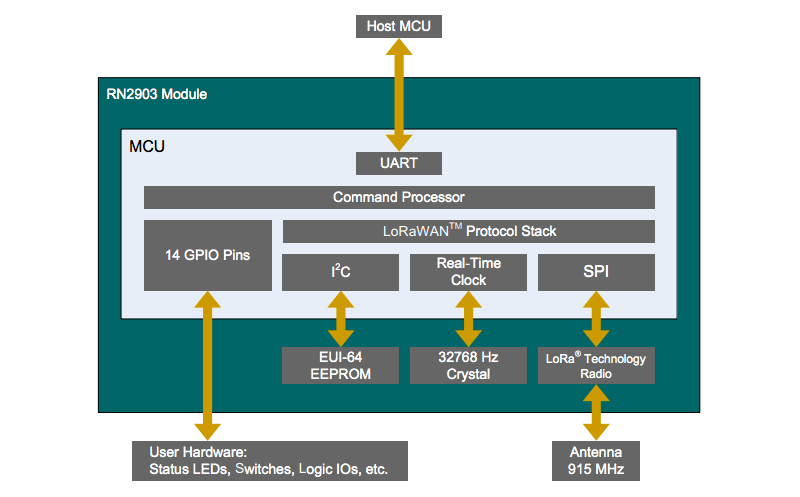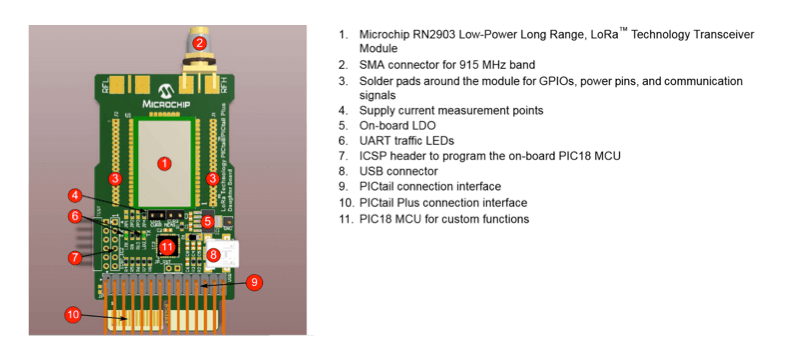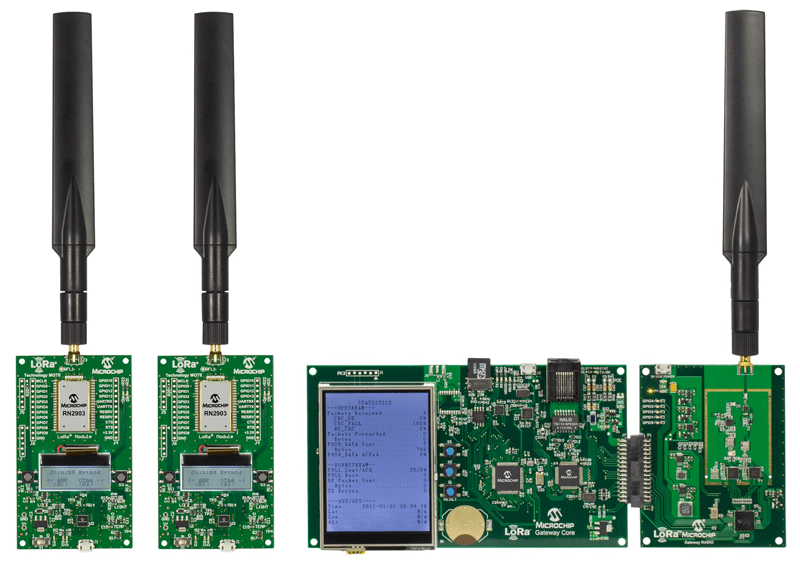The LoRaWAN as an IoT Network Solution
Wireless Solutions Part 1
While arrays of sensors are integral to any Internet of Things (IoT) installation, their value depends critically on the quality of their machine to machine (M2M) communications channels. For many familiar applications, such as those in homes or manufacturing plants, sensors use local area networks like Bluetooth, Wi-Fi, ZigBee or ANT. These are good for sensor to gateway links measured in metres.
However, there is a growing number of city infrastructure or other IoT systems that are spread over a much wider area; sensors can be located at distances of kilometres rather than metres from the nearest gateway. These long distances call for a different type of wireless communications solution. Two approaches are available; one based on cellular technology, the other on low-power wide area networks (LPWANs), especially LoRaWAN and SigFox.
This article is about LoRaWAN. We discuss its nature and its underlying technology, and then show how developers can start to engage with the standard with a currently-available end-device chip and associated demonstration kit. Then, to provide a context, we compare LoRaWAN with cellular solutions, as well as another popular LPWAN -SigFox. Next, we give an example of how designers and users can take advantage of LoRaWAN’s licence-free model to gain low-cost and simple access to the network.
LoRaWAN’s character and purpose
LoRaWAN is a LPWAN specification that allows battery-powered devices to connect to an IoT network over a long range, using a low bandwidth, in a regional, national or global network. It is intended as a low-cost, open standard with easy accessibility; it doesn’t require WiFi-type passwords or mobile subscriptions.
Note that while the terms ‘LoRa’ and ‘LoRaWAN’ are often used synonymously, the two refer to different things. The latter is the LPWAN protocol standard that stays in operation in a LoRa technology environment.
Semtech, producers of LoRa modules and technologies, is rolling out LoRa networks to 15 major US cities in collaboration with Comcast, which provides an enterprise IoT network service that uses the LoRa networks.
In another example, the Calderdale Flood Sensor Network supports a simple LoRaWAN application. Experimentation is going ahead with initially one but then more sensors in flood-critical locations besides the river, with LoRaWAN connections.
These can be up to 15 km line of site from the scheme’s single gateway, and keep people better-informed about river levels and flooding potential. The sensors can be allocated to local residents willing to host them and change their batteries once a year.
LoRa advantages
Semtech, developers of LoRa technology, has defined the following advantages for the protocol:
- Long range, up to 10 miles. In built-up environments, ‘long range’ can mean ‘great penetration and resilience’.
- Up to 10 years’ battery life
- Easily connect millions of nodes to LoRa concentrators
- Eliminates repeaters and infrastructure costs
- Significantly improves robustness to interference, noise and jamming
- High accuracy localisation and ranging
LoRa technology
The LoRA Alliance defines LoRaWAN network architecture as typically laid out in a star-of-stars topology in which gateways act as transparent bridges relaying messages between end-devices and a central network server in the backend.
Gateways are connected to the network server via standard IP connections while end-devices use single-hop wireless communication to one or many gateways. End-point communication is generally bi-directional, but also supports operation such as multicast, enabling software upgrade over the air or other mass distribution messages to reduce the on-air communication time.
Communication between end-devices and gateways is spread between different frequency channels and data rates. Data rate selection is a trade-off between communication range and message duration. Due to the spread spectrum technology, communications with different data rates do not interfere with one another and create a set of "virtual" channels, increasing the capacity of the gateway. LoRaWAN data rates range from 0.3 kbps to 50 kbps. To maximize both battery life of the end-devices and overall network capacity, the LoRaWAN network server manages the data rate and RF output for each end-device individually through an adaptive data rate (ADR) scheme.
LoRaWAN actual and potential implementations frequently have a critical requirement for secure communication. Protection is provided by several layers of encryption:
- Unique Network key (EUI64) ensures security at network level
- Unique Application key (EUI64) ensures end to end security at application level
- Device specific key (EUI128)
LoRaWAN has several end-point device classes to address its wide range of applications and their diverse needs:
- Bi-directional end-devices (Class A): Class A end-devices allow for bi-directional communications in which each end-device's uplink transmission is followed by two short downlink receive windows. The transmission slot scheduled by the end-device is based on its own communication needs with a small variation based on a random time basis (ALOHA protocol type). This Class A operation is the lowest power end-device system for applications that only require downlink communication from the server shortly after the end-device has sent an uplink transmission. Downlink communications from the server at any other time must wait until the next scheduled uplink.
- Bi-directional end-devices with scheduled receive slots (Class B): In addition to the Class A random receive windows, Class B devices open extra receive windows at scheduled times. The End-device receives a time-synchronized Beacon from the gateway, to ensure it open its receive window at the scheduled time. This allows the server to be aware of when the end-device is listening.
- Bi-directional end-devices with maximal receive slots (Class C): Class C end-devices have nearly continuously open receive windows, which only close during transmission.
LoRa Network options
Currently, two LoRa network options exist; Private Network and Public Network.
Private networks can be individually managed networks, or local area networks. These comprise:
- End-devices
- LoRa technology gateway
- Lora technology network server
Private IoT network examples include metering, security, home automation and industrial control.
Public networks are a much more scalable model, and can be telecom- or operator-managed, or nationally deployed. They comprise:
- End-devices
- LoRa technology gateway
- LoRa technology public network operator (Telecom)
- Lora technology network server
Telecom companies integrate gateways on towers and provide network service. Providers include Bouygues, KPN, Vodafone and Swisscom in Europe, and SingTel in Asia.
LoRaWAN device overview and block diagram
Semiconductor manufacturer Microchip produces a range of LoRaWAN modules. One example is the RN2483 low-power long range transceiver module, which provides an easy to use, low-power solution for long range wireless data transmission with an advanced command interface.
The module complies with the LoRaWAN Class A protocol specifications. It integrates RF, a baseband controller and command Application Programming Interface (API) processor into a complete long-range solution. The module is suitable for simple long-range sensor applications when used with an external host MCU.
Using LoRa Technology modulation techniques, the RN2483 can achieve a receiver sensitivity of -146 dBm. This high sensitivity combined with the integrated +18.5 dBm output power amplifier yields industry-leading link budget, which optimises it for applications requiring extended range and robustness.
LoRa Technology modulation also provides significant advantages in both blocking and selectivity compared to conventional modulation techniques, solving the traditional design compromise between extended range, interference immunity, and low power consumption.
Fig.1 shows a block diagram of the module.

Fig. 1: RN2483 low-power long range transceiver module block diagram – Image via Microchip © 2015 – 2017 Microchip Technology Inc.
LoRaWAN end-device module and development kit
The Microchip RN2483 is a fully-certified 915 MHz module based on LoRa technology. The chip utilizes a unique spread spectrum modulation within the Sub-GHz band to enable long range, low power, and high network capacity.
The module's embedded LoRaWAN™ Class A protocol enables seamless connectivity to any LoRaWAN compliant network infrastructure, whether public or privately deployed. The module is specifically designed for ease of use, which shortens development time and speeds time to market. LoRa technology is ideal for battery-operated sensors and low power applications such as IoT, M2M, Smart City, sensor networks, industrial automation, and more.
You can demonstrate the RN2483’s capabilities with an RN2483 LoRa Technology PICtail /PICtail Plus Daughterboard/demonstration board , as shown in Fig.2.

Fig.2: RN2483 LoRa Technology PICtail /PICtail Plus Daughterboard – Image via Microchip
The high-speed UART interface and the GPIO ports are available on the module to configure, control, and transfer data. The RN2483 LoRa Technology PICtail/PICtail Plus Daughter Board has PICtail and PICtail Plus connectors to interface with a PIC® Microcontroller (MCU) on the development boards that support a PICtail or PICtail Plus interface with the required pin mapping. The PICtail board also has an on-board PIC18MCU preprogrammed to provide a simple USB-to-UART serial bridge, enabling easy serial connection. This MCU can be reprogrammed for custom user functions.
You can run the demonstration by plugging the daughter board into a PC USB port. The port powers the daughter board and allows you to communicate using the RN2483 ’s ASCII commands. Development of the RN2483 with Microchip’s PIC MCU line is possible either by plugging the 28-pin PICtail connector into a PIC18 Explorer, or by connecting the 30-pin card edge PICtail Plus connector to an Explorer 16.
Other manufacturers’ LoRa Technology products
We have used the Microchip RN2483 as an example of a LoRa Technology implementation, but other manufacturers also produce low power transmitters that support LoRa - particularly Semtech, who own the proprietary LoRa chirp spread spectrum (CSS) technology used by Microchip and any other LoRa device.
Examples include:
- Semtech SX 1272/73 860 MHz to 1020 MHz Low Power Long Range Transceiver modem
- Texas Instruments CC1310 SimpleLink Sub-1 GHz Ultra-Low Power Wireless Microcontroller
- HOPERF RFM95W 868/915 MHz RF Transceiver module
Other manufacturers include ST-Microelectronics and RF Solutions.
Note that many manufacturers also offer gateways. One example is Microchip’s DV1644140-2 as shown in Fig.3. For DIYers, Internet searches will reveal kits and instructions on how to build gateways based on the Raspberry Pi.
LoRaWAN vs Cellular
We mentioned previously that long-haul IoT designers have a fundamental choice between LPWANs such as LoRaWAN and SigFox, or cellular technology – but how do they stack up against one another?
As a first step in such a comparison, it’s necessary to decide which cellular standard is the most appropriate candidate. Currently, the strongest contender is NB-IoT as it is a cellular-based, low-power, wide area networking technology produced by 3GPP for IoT users. It is one of several licensed-spectrum technologies designed to provide low throughput, deep coverage and low power consumption for very long battery life of 10 to 20 years – a period not possible with traditional cellular 2G, 3G or 4G standards. As a result, cellular connectivity becomes a viable alternative to non-cellular LPWA technologies.
An article by Hussain Fakhruddin, CEO at Teknowledge Software, contains a detailed comparison of the alternatives, which is summarised below:
Bandwidth support
NB-IoT typically works on a slightly higher bandwidth than LoRaWAN. The signal bandwidth requirement for the 3GPP technology is 180 KHz – a couple of levels higher than the 125 KHz support offered by Semtech’s LoRa technology.
Need for gateways
The LoRa needs dedicated gateways to function, while the NB-IoT infrastructure is set up by connecting the base stations with the sensors directly. However, there is an argument that, depending on the terminology used, interface and functionality of devices, gateways and base stations are practically interchangeable items. Hence, for both, NB-IoT and LoRa, gateways (or base stations) are required for functioning.
Frequency spectrums required
The LoRa IoT technology works on an unlicensed spectrum (As does SigFox). Applications powered by LoRaWAN, hence, have minimal costs – while battery performance receives a boost. Unlike the asynchronous protocol of LoRa, NB-IoT services are synchronized and they are provided over licensed frequency bands (both LoRa and NB-IoT use frequency bands lower than 1GHz). The cost for frequency band licensing is significant.
Suitability for different types of applications
The two technologies are optimised for different types of final applications. For instance, LoRaWAN is deemed ideal for apps/devices that have non-frequent communication requirements (say, a couple of times in a day), and must deliver top-notch battery lives at very low costs. In comparison, the NB-IoT specification works best for applications that need to have minimal latency and are required to communicate more frequently. Both the IoT protocols have their own unique value propositions – and each has use cases which cannot be served by the other.
Customer profiles
Leading telecom operators are the main customers for IoT and M2M communication standards like LoRa, NB-IoT and SigFox. However, the LoRa technology can be used by non-telecom operators as well. Networking initiatives that are crowd-sourced can easily access and implement LoRa based IoT solutions; The Things Network already does this.
Network coverage
While NB-IoT can reach further than LoRa – 18-21 km compared with 12-15 km – NB-IoT performs less well in suburban or rural areas without strong, glitch-free 4G coverage. Since LoRaWAN does not rely on cellular data or Wi-Fi for functioning, its coverage remains relatively steady across all types of locations.
Also, the LoRa base stations can be built at a fraction of the cost associated with the 4G-LTE base stations required by NB-IoT. These savings are a significant advantage for LoRa.
Battery performance
Since NB-IoT works on a cellular, licensed spectrum, the devices must be synced with the network at regular (and relatively frequent) intervals. This consumes battery power. No such network synchronisation is required by LoRa architectures. In the asynchronous bands used for LoRa, the precise nature of the end-application determines how long a device can sleep, so battery life can be easily conserved.
Data rates
The average data rate in a NB-IoT narrow band setup is 200 Kbps, about 20 times faster than LoRa. The higher data rates of NB-IoT make it ideal for implementation in applications that require quicker data throughputs. The LoRa technology does what it is meant to do well enough – but NB-IoT is easily the more efficient IoT protocol for faster applications.
Cost
Low cost is essential to IoT viability, and LoRaWAN holds the aces here. The overall cost of LoRaWAN modules hovers at around $8-10 – about half the price of cellular LTE modules like NB-IoT. The NB-IoT network’s greater complexity, the IP-royalty issues related to licensed band operation, and the higher silicon area required combine to push up the total NB-IoT costs. Additionally, upgrading to advanced 4G/LTE base stations for NB-IoT is a much more expensive affair than LoRa deployments through industrial gateways or tower-top gateways. As more integrations happen and markets mature, LoRa technology costs are expected to drop further.
We can see from these factors that each technology has its own advantages and drawbacks; the best choice depends on the application. Time will tell which if either standard emerges as the undisputed leader in the LPWAN market.
LoRa vs SigFox
Although the networks position themselves similarly in the IoT market, they have significant technological and marketing differences. While SigFox aims to become a global IoT operator, the LoRa Alliance wants to provide a technology that allows other companies to enable global IoT implementations. The Table in Fig.4 and notes below show the key differences between the technologies:

Fig. 4: Table showing differences between LoRa and SigFox
Unlike SigFox, standard LoRa modules can operate in a bidirectional way. Using the same radio module, a receiver can be transformed into a transmitter at any given moment and vice versa.
Therefore, LoRa is more adapted to command-and-control scenarios.
SigFox offers a very simple API to integrate the radio module. However, LoRa offers a highly configurable low-level API, which makes different optimizations possible. The tradeoff is that this makes integration of the LoRa radio module more complicated than SigFox.
SigFox messages are limited by design to 12 bytes. For LoRa, message length is defined by the user. To ensure compliance with regulations, developers must ensure that radio messages do not last longer than five seconds over the air.
Both technologies offer some security functions. However, only SigFox identifies and authenticates devices.
Both networks provide high resistance to communication jamming because transmissions are achieved through one-sided communications without any network authorisation.
Some LoRaWAN proponents
The interests and technical development of the LoRa protocol are being promoted by the LoRa Alliance . The LoRa Alliance is an open, non-profit association of members that believes the Internet of Things era is now. It was initiated by industry leaders with a mission to standardize Low Power Wide Area Networks (LPWAN) being deployed around the world to enable Internet of Things (IoT), machine-to-machine (M2M), smart city, and industrial applications. The Alliance members will collaborate to drive the global success of the LoRa protocol (LoRaWAN), by sharing knowledge and experience to guarantee interoperability between operators in one open global standard.
A highly attractive aspect of LoRaWAN is its availability without need for licensing. The Things Network (TTN) is an organisation that builds on this platform by providing a network that anyone can connect to by investing typically $500 to $1500 in a low-cost gateway. There is no need to involve major telcos in this community-based scenario, while TTN has become established in 89 countries so far.
The organisation is working to make its network as decentralised as possible, without any points of failure or control. Users are encouraged to join their forum, or start their own communities to expand the network.
Conclusions
In this article we have seen how LoRaWAN technology is offering developers an attractive route to build IoT installations involving sensors located at kilometres rather than metres from the nearest gateway. Many manufacturers now offer relatively low-cost end devices and gateways, and entry into LoRaWAN network infrastructures can be licence-free.
There are other long-range cellular and non-cellular LPWAN alternatives available, but LoRaWAN has a significant role to play, with many installations already in place around the world.
References
https://www.lora-alliance.org/technology
http://ww1.microchip.com/downloads/en/DeviceDoc/50002390C.pdf
http://www.microchip.com/wwwproducts/en/RN2903
http://www.ti.com/product/cc1310
http://www.hoperf.com/rf_transceiver/lora/RFM95W.html
http://www.amihotechnology.com/loravsnbiot
https://raed.it/blog/iot-network-sigfox-vs-lora
The LoRaWAN as an IoT Network Solution - Wireless Solutions Part 1. Date published: 29th August 2017 by Farnell element14
